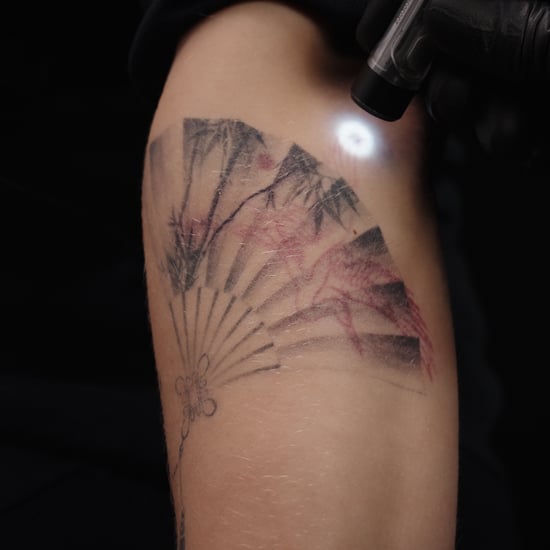What Is Osteopathy and Who Is it Best For? What to Expect
Why an Osteopath Visit Is the One Beauty Step You Shouldn't Miss

Our skin-care routines are down to a fine art at this point, we drop things like "gut microbiome" into sentences with ease, and we're well versed in the latest workout craze. When it comes to external and internal wellness, we've never been more informed than right now — yet, there's a crucial component to our health that so many of us have overlooked.
Our posture can affect so much more than just how we appear. It's something that became much more evident during lockdown with hours spent working from home, sitting, and lying down — plus much less walking and standing. In just a few weeks, my back and neck became stiffer from an even more sedentary lifestyle than it had been before, to the point where I had a persistent ache in my lower back and shoulders. I was sluggish, always tired despite good sleep quality, and my digestive issues had never been worse. As soon as life opened up again after lockdown, I knew I had to find an osteopath. In just three sessions, I'd gained back so much more mobility and discovered issues that had silently been building up for years.
Loved by Princess Diana, osteopathy is where posture and spinal work meets holistic care for optimising health at any age, from birth to old age. Diana's memorial fund donated to London's Osteopathic Centre for Children, where my mother had taken my sister and I from the age of 1. Whether it was finding and fixing the root of endless bouts of colds and flu, or correcting birth trauma using cranial osteopathy, our visits supplemented our GP appointments for an all-round approach. I found exactly that, 20 years later, when I visited Nadia Alibhai at her clinic Back 2 Wellbeing. Read on for her full breakdown into what osteopathy is, who needs it (spoiler: pretty much everyone does), and how to find a gold-standard osteo.
What Is Osteopathy? Is It the Same as Seeing a Chiropractor?
While the two often get mixed up, an osteopath has a pretty different approach than a chiropractor. "Osteopathy is more holistic, working from the spine outward to help the body overall — and most osteopaths don't work on muscles, but I do," Alibhai tells POPSUGAR. "Chiropractors do look at the spine, but work on the basis that all injuries and ailments come from the spine. That work is based on manipulating and adjusting the spine, realigning it to get everything in tune. There's no need for both: just choose which suits you best and maybe supplement with some physiotherapy if needed."
Who Can Benefit From Visiting an Osteopath?
Everyone and anyone can benefit from seeing an osteopath, and you needn't wait until something is wrong to see one. "Osteopathy isn't just for when you have injury or pain — see it more like a MOT," says Alibhai. "We use bodies all day, taking on lifestyle choices and hobbies like knitting (and texting!) that change posture over years. People spend so much maintaining their cars, only to get a new one — but you can't buy a new body. Osteopaths help with prevention and can spot the problem areas you don't."
I'd initially visited Alibhai to help my posture and back pain, but within the first five minutes, she alerted me that one part of my jaw was differently shaped to the other from chewing on one side too much, my head and neck entered the room before the rest of the body (which can lead to a dowager's hump), and I could barely look behind each shoulder as I'd tightened up so much. "Posture correction is always going to be better than curing later down the line — not just when you notice a humpback," adds Alibhai. People need to look at posture as prevention better than cure, not just when you notice humpback. Disc injuries, sciatica, and gut issues can all benefit.
What Can Osteopathy Help With?
"Anything more serious can be aided, such as disc injuries or sciatica," Alibhai explains. "But something a lot of people don't realise osteopathy truly works brilliantly on is gut issues. When we're hunched at our desks or watching TV, that seated posture closes up the gut and doesn't let digestion work to the max. We're in turn more sluggish and have bowel issues." In fact, many of Alibhai's patients have seen the most dramatic improvement via having bowel issue remedied. In turn, this has helped many people's anxiety. "It's something I'm looking more and more into, but osteopathy can be a huge help for anxious patients," says Alibhai. "I focus on the vagus nerve in the body, which runs from the brain to the gut." As an anxiety sufferer, I did feel that it eased up considerably for days after my sessions with Alibhai.
What Happens at an Osteopath Appointment?
Osteopaths often hold introductory appointments for 30 minutes to an hour and a half, so you can test the waters. "When a client enters, my senses go on alert," Alibhai explains. "I check how they hold their head, if their jaw is clenched, their hand positions, and how they sit and stand. As they talk, I listen to how they sound and their energy, how they're breathing. I can tell within 10 seconds if they need help. Then I touch and feel them rather than just listening to them reel off symptoms."
My initial session with Alibhai involved some talk about diet, energy levels, lifestyle, and then some gentle movement exercises, so she could see everything in motion. Then I lay on the table while she moved my joints, satisfyingly cracking them where needed to release tension, and pushing pressure points in my feet. Immediately afterwards, my entire body felt lighter and much more fluid, and I could look behind each shoulder a few more inches, something I really struggled with prior to the session.
How Often Should You See an Osteopath?
"Every season is enough if you have no major issues," Alibhai advises. "Especially if you're starting a new workout routine, which can change your posture, even for the worse if you're not aligned correctly. There's definitely no need to spend thousands of pounds a year and go in for loads of sessions," she says. "In between appointments, be sure to stay aware of how you're sitting and lubricate joints by taking standing and walking breaks. Good exercise programs will include stretching and strengthening muscles to stay limber, including dynamic yoga, resistance bands, or weightlifting to help nutrients flow through the bones. Take time to reconnect with your body, practice breathwork and mindfulness. And finally, take your supplements like omega 3 and vitamin D, and get some sunlight."
How Do I Find a Good Osteopath?
Finding an osteopath is a little like finding the rest of your "beauty people", it can take time and trial and error. "Always be mindful of who you're trusting your body with," warns Alibhai. "You should be able to voice your concerns freely and not feel judgement, and not feel pressured to book a treatment package instead of an initial taster session."
Alibhai's Osteopathy Checklist Includes:
- Make sure they're registered with the General Osteopathic Council
- Bonus points if you've been recommended them by someone
- Having good experience rather than a fresh graduate — who may be great with knowledge but not advanced with touch compared to someone with 5-20 years of experience
- Listen to how you feel in the session. Are they listening and understanding? Are they looking at everything in relation to your problem area, not just focusing on that?
You can book an introductory session with Nadia Alibhai and her team at Back 2 Wellbeing. Sessions start at £80 an hour with follow up sessions from £55.






